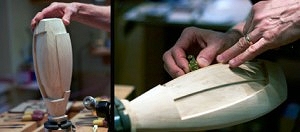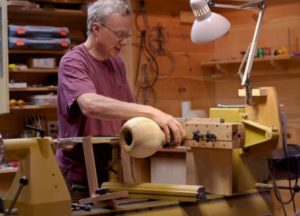

 I met Mark Baker at the 2012 AAW Symposium in San Jose, California where he saw my work in the Instant Gallery. Mark, the Group Editor for the woodworking magazines published by the Guild of Master Craftsman Publications in East Sussex, England asked if I would be interested in having some photos of my work featured in an issue of “Woodturning” magazine. I was thrilled and agreed right away. In following up, Tegan Foley of “Woodturning” asked if I would answer some questions for a feature called “Twenty Minutes with Roman Stankus”. In the process of responding, I realized the content would make a nice bio for my website.
I met Mark Baker at the 2012 AAW Symposium in San Jose, California where he saw my work in the Instant Gallery. Mark, the Group Editor for the woodworking magazines published by the Guild of Master Craftsman Publications in East Sussex, England asked if I would be interested in having some photos of my work featured in an issue of “Woodturning” magazine. I was thrilled and agreed right away. In following up, Tegan Foley of “Woodturning” asked if I would answer some questions for a feature called “Twenty Minutes with Roman Stankus”. In the process of responding, I realized the content would make a nice bio for my website. is experimental and exploratory. I am currently producing non-functional pieces that investigate sculptural form, color, texture, and artistic composition. The basic forms of my pieces are created on the lathe and completed using a variety of methods including, routing, carving, burning, texturing and coloring. I am also using eccentric/multi axis turning methods and have developed and adapted a number of tools and techniques to achieve specific forms/geometries that interest me. I also produce some traditionally turned pieces.
is experimental and exploratory. I am currently producing non-functional pieces that investigate sculptural form, color, texture, and artistic composition. The basic forms of my pieces are created on the lathe and completed using a variety of methods including, routing, carving, burning, texturing and coloring. I am also using eccentric/multi axis turning methods and have developed and adapted a number of tools and techniques to achieve specific forms/geometries that interest me. I also produce some traditionally turned pieces. Tell us about your workshop. My workshop is a stand-alone building I constructed in my back yard on the foundation of an old garage – approximately 18 x 32 feet with a storage loft. I have a power tool room with a complete set of compact power tools for doing traditional “flat” woodwork along with a Powermatic and a Conover lathe. I also have a separate smaller room with a workbench and many hand tools where I do “off the lathe” processes. I like to listen to music while I work. The shop is insulated well so it is quiet if I need it to be and it is a great place to focus on my work.
Tell us about your workshop. My workshop is a stand-alone building I constructed in my back yard on the foundation of an old garage – approximately 18 x 32 feet with a storage loft. I have a power tool room with a complete set of compact power tools for doing traditional “flat” woodwork along with a Powermatic and a Conover lathe. I also have a separate smaller room with a workbench and many hand tools where I do “off the lathe” processes. I like to listen to music while I work. The shop is insulated well so it is quiet if I need it to be and it is a great place to focus on my work.